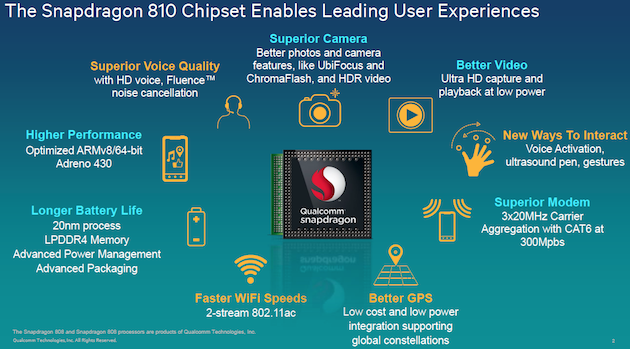It hasn’t been long since Qualcomm announced a refreshed Snapdragon 800 in the form of the 801, and we’re already witnessing the release of something that promises a lot more prowess from the fabricator.
Announced earlier today, the Qualcomm Snapdragon 810 and the 808 both rock the very much in the buzz 64-bit architecture (thanks to MediaTek, and the likes), and will follow the previously announced Snapdragon 610 and 615, which are based on the 64-bit architecture as well.
Gizchina News of the week
The Snapdragon 808 is quite the result of a mix-and-match scheme with 6 cores on board, two of which will be based on the Cortex A57 platform and the other 4 on Cortex A53. The SoC will feature support for up to 2K display and will rock an Adreno 418 GPU, which is advertised as a 20% faster Adreno 330.
The 810, on the other hand, is a complete storm trooper with eight cores on board. Unlike the MediaTek MT6592, the Snapdragon 810 will have 4x Cortex A57 + 4x Cortex A53 ones, with the former set to take centrestage during more hardware intensive tasks, while the latter to take control during the not-so-intensive tasks. Being a top of the range SoC, the 810 will have support for up to 4K video decode with the graphics department taken care of by the Adreno 430 GPU, which promises a 30% boost over the yet-to-come Adreno 420.
Both these powerhouses are scheduled for availability during the first half of 2015, so there’s still some time to go.
[Via]





“The 810, on the other hand, is a complete storm trooper with eight cores on board.” I heard a president of Qualcomm said that it’s insane to build CPU with more than 4 cores and now they have 8 cores. Even more, it is 64-bit architecture.
They even made a video laughing at Mediatek for their 8-core processor
They -did- have a point. Cortex-A7 is laughable. It’s 5(?) year old architecture.
they meant running all 8 cores in parallel, not a big-little configuration like this where performance and energy-efficiency responsibilities are divided between heterogeneous clusters of 4 cores.
I am sorry but I think that CPU cores state can be controlled by hardware/software. You can install CPU-Z, and even in MTK6577 you can see that sometimes one core goes stop. And 8-cores work parallel in case you have an application uses 8 threads, which mean it can get benefit about speed. Of course, it will eat more energy. I am not deny the effect of big.Little structure, but sure that you can find this sentence in wikipedia
“The most powerful use model of big.LITTLE is heterogeneous
multi-processing (MP), which enables the use of all physical cores at
the same time. ”
As you can see, it really has no different since 8-core run parallel, just with 6592 8 cores has the same priority but in big.LITTLE 8-cores, you can have big core for more power work and little core for less power work. Of course, big.LITTLE is more effective than normal 8-cores.